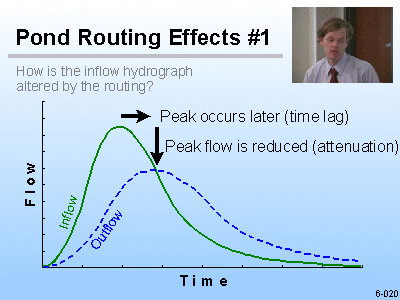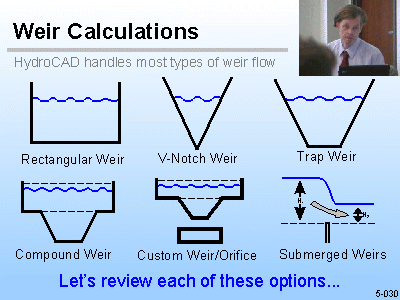 Pond FAQ
Pond FAQ
This document discusses general issues about the use of a "pond" within
HydroCAD.
What is a
pond?
 A pond is used to model a reservoir, dam, catch basin, manhole, drywell,
storage chamber, vault, or other impoundment that fills with water from one or
more sources and empties in a manner determined by a weir, culvert, orifice, or
other outlet devices. "Zero storage ponds" may also be used to model
certain storm sewers.
A pond is used to model a reservoir, dam, catch basin, manhole, drywell,
storage chamber, vault, or other impoundment that fills with water from one or
more sources and empties in a manner determined by a weir, culvert, orifice, or
other outlet devices. "Zero storage ponds" may also be used to model
certain storm sewers.
 How is the outflow calculated?
How is the outflow calculated?
The outflow of each pond is determined by a hydrograph routing calculation
which typically attenuates and delays the peak flow. Advanced routing procedures
offer the ability to model tailwater conditions such
as pond-to-pond
routing, often known as "coupled ponds" or "interconnected ponds."
How is the outflow routed?
A pond may empty into a reach or into another pond.
An optional secondary and tertiary outflow may be used to divert the discharge from
specific outlet devices (such as an emergency spillway) and route it separately.
A discarded outflow is also available for outflows that are not subject
to further routing, such as exfiltration.
 How is the storage calculated?
How is the storage calculated?
Pond storage may be entered directly, or calculated automatically for a wide
range of shapes and conditions. For details read about
pond storage.
HydroCAD also provides a special pond sizing report
that can be used to do an initial estimate of the storage required to attenuate
a given inflow to a specific target level. Final pond sizing is an
iterative process based on the HydroCAD simulation and the specific design
objectives.
How is the
discharge calculated?
HydroCAD provides a wide range of
outlet control options, including orifice,
weir, culvert, and exfiltration calculations.
These can be used in various combinations to model more complex outlets, such as
a riser structure.
What other calculations are performed?
 After performing the hydrograph routing (as described above), HydroCAD also
calculates the detention time.
After performing the hydrograph routing (as described above), HydroCAD also
calculates the detention time.
What about rainfall on a pond?
Except for underground storage, you need to include the pond's area within one of your subcatchments, or set up a separate subcat
with a Tc of zero and a CN of 98-100. This will produce instantaneous runoff equal to
the precipitation. Starting with HydroCAD 8.5,
you can use one of the new entries in the CN lookup table that allow the water
surface to be reported as pervious or impervious.
Are there other uses for a pond?
A "pond" can also be used to evaluate hydraulic devices that have no
effective storage, such as a diversion or flow splitter.
In these situations, HydroCAD apportions the flow between the outlet devices
based on the calculated headwater elevation.